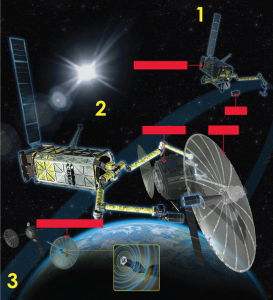The keen-eyed folks at Inhabitat have identified a useful way of re-using wooden pallets; you can read about this furniture project, developed by James Higginson – turning pallets into cabinets. Not for beginners, we think, but in any case it’s inspired: the pallets are common, are abandoned as soon as they’re damaged, and, it’s clear, that in the right hands they can be repurposed as beautiful cabinets.
Category Archives: Reduce-Reuse-Recycle
DARPA to Re-Use Components of Satellites
Katharine Gammon, at Popular Science, reports on the DARPA Phoenix Project, to reuse of components of obsolete or non-working satellites, here,
Approximately 1,300 nonfunctional satellites sit in a graveyard orbit 22,000 miles above Earth—and DARPA has plans for them. Recycling dead satellite parts in space could be 10 times cheaper than building and sending up new satellites, says DARPA program manager Dave Barnhart. Earlier this year, the agency started the Phoenix project, which will use robots to salvage parts from decommissioned satellites as soon as 2015.
When a satellite in orbit 22,000 miles above earth fails it doesn’t fall to earth. And many components such as antenna and solar arrays, remain functional. Rather then launch a spacecraft to ship a whole new replacement satellite into orbit, DARPA the Defense Advanced Projects Research Agency, the government agency that brought us the Internet. is planning on reusing these components – at 10% of the cost of a new satellite.
Notre Dame researchers: new way of cleaning up and recycling nuclear waste
Physorg reports a new way to clean up the waste from nuclear operations:
A new paper by researchers at the University of Notre Dame, led by Thomas E. Albrecht-Schmitt, professor of civil engineering and geological sciences and concurrent professor of chemistry and biochemistry, showcases Notre Dame Thorium Borate-1 (NDTB-1) as a crystalline compound which can be tailored to safely absorb radioactive ions from nuclear waste streams. Once captured the radioactive ions can then be exchanged for higher charged species of a similar size, recycling the material for re-use.
If one considers that the radionuclide technetium (99Tc) is present in the nuclear waste at most storage sites around the world, the math becomes simple. There are more than 436 nuclear power plants operating in 30 countries; that is a lot of nuclear waste. In fact, approximately 305 metric tons of 99Tc was generated from nuclear reactors and weapons testing from 1943 through 2010. Its safe storage has been an issue for decades.“The framework of the NDTB-1 is key,” says Albrecht-Schmitt. “Each crystal contains a framework of channels and cages featuring billions of tiny pores, which allow for the interchange of anions with a variety of environmental contaminants, especially those used in the nuclear industry, such as chromate and pertechnetate.”
Dutch apartments built from defunct water treatment plant
Tafline Laylin, writing at Inhabitat – a brilliant blog whose work we should be bringing to our readers’ attention more often, describes how – instead of demolishing a water treatment plant’s structures to make space for housing – it was repurposed and made part of the housing. This is a multiple success – resources conserved in demolition, construction, a “dirty” site made functional, and top all that, it’s beautiful. Here’s one image from Laylin’s piece, Defunct Dutch Sewage Plant Converted into Fresh Green Apartments:
"Cantenna" – improvised antenna
A “Cantenna”: improvised antenna, reused materials, can extend transmission and reception of a variety of radio devices – a paint or other metal can, plus copper wire or brass rod, brass tubing – can extend the range of radios, cell phones, wireless networks. Here’s one example from Wikipedia’s entry Cantenna:
Plastic Bags: a not-so-disposable problem, and the aggregate of small solutions
From reuseit.com, here are some Fast Facts on Plastic Bags:
- 500 billion to 1 trillion plastic bags are used every year, worldwide.
- About 1 million plastic bags are used every minute.
- A single plastic bag can take up to 1,000 years to degrade.
- More than 3.5 million tons of plastic bags, sacks and wraps were discarded in 2008.
- Only 1 in 200 plastic bags in the UK are recycled (BBC).
- The U.S. goes through 100 billion single-use plastic bags. This costs retailers about $4 billion a year.
- Plastic bags are the second-most common type of ocean refuse, after cigarette butts (2008)
- Plastic bags remain toxic even after they break down.
- Every square mile of ocean has about 46,000 pieces of plastic floating in it.
We’re talking about, we suspect, two main uses: bags used in the transportation of goods – and bags used to transport “waste,” including the garbage bags themselves, discarded shopping bags – and sometimes shopping bags re-used as garbage bags.
Tara Lohan, in The Great Plastic Bag Plague, (On Alternet, 2007), cites industry sources for the proposition that American retailers spend $4 billion/year on plastic bags – adding, of course, to the cost of goods – without reflecting their full environmental cost. Lohan cites other sources for the proposition that 12 million barrels of oil are used , annually, to produce plastic bags used in the United States. The U.S. Energy Information Administration estimates that average daily use of petroleum products in the United States – the world’s largest consumer – is 18,771,000 barrels/day. Assuming we’re not in a leap year – 1/365th is .0027 (rounded) of our energy consumption. Put another way, slightly over one-quarter of one percent (0.27%). And 12 million barrels would be about two-thirds of that. Thought of another way – 18 million barrels per day – 365 days per year – 6.5 billion (6,570,000,000). So plastic bags amount to 0.18% of our petroleum consumption. 1 component of 6,570 equal components. So what difference does it make if you accept a plastic bag, or bring your own reusable bag?
In WW II ((One of the ways in which the Allies gradually wore down the Axis was by depriving it of – no surprise, we hope – petroleum. Richard Overy, in Why The Allies Won, contends that Allies’ gradual degradation of Axis energy supplies made a great contribution to the eventual Allied Victory.)) , three million soldiers retook the continent (the invasion of Western Europe, sometimes referred to as Operation Overlord) during and after D-Day. Each soldier’s contribution amounted to 0.12% One in three million – without counting the various Resistance groups, support troops and civilians in the United Kingdom and the United States. Total U.S. troop count: 16.5 million. The Philippines suffered over 50,000 military deaths alone. (For total WW II casualties, see Wikipedia entry of that name).
So – the aggregate of many small, coordinated contributions is dramatic. Get a reusable shopping bag, and use it. In future posts, we hope to point out some good deals on reusable bags, and revisit the principle of aggregating small acts. For an always-brilliant take on individual action about energy, particularly heating, check out Ellen Honigstock’s ToePrint Project.
And:
Our earlier post, International Herald Tribune: Ireland rids itself of a plastic nuisance – Ireland’s early success with a small tax on disposable bags.





